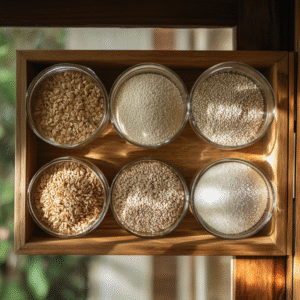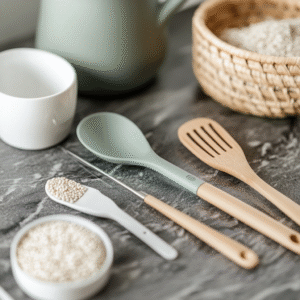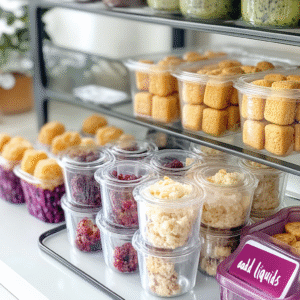1. Introduction: Mastering Grain-Free, Plant-Powered Baking
Gluten-Free Vegan Baking Tips unlock the door to moist breads, tender cakes, and chewy cookies—all without wheat, eggs, or dairy. Whether you’re baking for celiac guests, managing gluten sensitivity, or simply exploring a grain-free lifestyle, understanding the interplay of alternative flours, vegan binders, and leavening agents is essential. In this guide, you’ll learn how to:
Select & blend flours for optimal structure and flavor
Use binders like psyllium, flax, and chia to mimic gluten’s elasticity
Troubleshoot common issues—dry crumbs, dense crumbs, pale crusts
Apply advanced tips (spices, extracts, chilling dough) to elevate every recipe
Create five standout recipes—from sandwich bread to peanut-butter cookies
Integrate meal-prep hacks for busy weeks
Along the way, you’ll find internal links to our Vegan Meal Prep: Stress-Free Plan and external video tutorials and expert resources to ensure every bake is a success.
2. Why Gluten-Free & Vegan Baking Matters
Celiac disease affects ~1% of people worldwide, and non-celiac gluten sensitivity up to 6% YouTube. At the same time, veganism removes dairy and eggs—two of the top eight allergens. Combining gluten-free and vegan approaches:
Expands inclusivity for guests with multiple restrictions
Emphasizes whole foods, boosting fiber, phytonutrients, and healthy fats
Reduces inflammatory triggers, often found in refined wheat, dairy, and eggs
Encourages creativity, discovering new staples (tapioca, sorghum, nuts)
By mastering these tips, you ensure flavorful, reliable bakes that nourish and delight every eater at your table.
3. The Flour Powerhouse: Building Your Blend
3.1 Key Gluten-Free Flours & Their Roles
| Flour Type | Texture & Flavor | Best For |
|---|---|---|
| Brown Rice Flour | Neutral, slightly gritty | Cakes, bread, pancakes |
| Oat Flour | Tender, mild sweetness | Muffins, cookies |
| Almond Flour | Rich, moist, nutty | Quick breads, crusts |
| Tapioca Starch | Chewy, elastic | Breads, pizza crust |
| Sorghum Flour | Earthy, protein-rich | Breads, muffins |
Blend guidelines:
Start with a 50:50 ratio of grain (rice/oat) to nut/starch (almond/tapioca).
Adjust water/oil content to compensate: add 2–3 Tbsp plant milk and 1 Tbsp oil per cup of flour.
For higher protein, swap ¼ cup almond for rice flour; for lighter crumb, increase tapioca by 10 %.
3.2 Binders & Leaveners
Without gluten’s glue, you need alternatives:
Psyllium Husk Powder (1 Tbsp per cup flour) gels with water, stabilizing bread and wrap doughs.
Ground Flax/Chia “Eggs” (1 Tbsp seed + 3 Tbsp water = 1 egg) bind cookies and muffins.
Xanthan Gum (¼ tsp per cup) adds elasticity in batters.
Agar-Agar (½ tsp) can improve the crumb in cakes when dissolved in warm plant milk.
Baking Powder & Soda + Acid (1 tsp powder; for soda: ¼ tsp + ½ tsp vinegar) ensure lift.
Mix binders thoroughly with dry ingredients to avoid clumps, then whisk in liquids in one direction to preserve air.

4. Flavor & Texture Tactics
4.1 Moisture Management
Gluten-free batters dry out quickly. Counteract by:
Adding extra fat: 1 Tbsp oil or melted coconut per cup of flour
Incorporating moisture traps: mashed banana, applesauce (¼ cup per cup flour)
Using hydrating mix-ins: shredded zucchini or carrot
4.2 Spice & Extract Enhancements
To mask whole-flour notes and add depth:
Extracts: vanilla, almond, lemon (1 tsp per batch)
Spices: cinnamon (½ tsp), cardamom (¼ tsp), ginger (⅛ tsp) in sweet recipes
Savory accents: nutritional yeast (1 Tbsp) and garlic powder in herb breads
4.3 Temperature & Baking Precision
Oven accuracy: use a thermometer; gluten-free recipes often bake 5–10 °F lower to prevent over-browning.
Mixing: stir just until combined; overmixing deflates trapped gas and causes dense crumb.
Resting: some batters (pancakes) benefit from a 10-minute rest to hydrate flours fully.
5. Five Tasty Recipes to Try Today
5.1 Fluffy Sandwich Bread
Ingredients:
1½ cups brown rice flour
1 cup tapioca starch
½ cup sorghum flour
1 Tbsp psyllium husk
2 tsp baking powder, 1 tsp salt
1 cup warm plant milk, 2 Tbsp oil, 1 Tbsp vinegar, 1 tsp sugar
Method: Whisk dry, whisk wet, combine into smooth batter. Pour into greased loaf pan; bake 350 °F/45 min. Cool fully before slicing to set crumb.
5.2 Blueberry-Lemon Muffins
Ingredients:
1 cup oat flour, ½ cup almond flour, ¼ cup tapioca starch
1 tsp baking soda, zest of 1 lemon, pinch salt, 2 Tbsp sugar
1 cup aquafaba, 2 Tbsp maple syrup, 1 tsp vanilla, 2 Tbsp oil, 1 cup blueberries
Method: Fold wet into dry until just combined; gently stir blueberries. Bake 375 °F/20 min.
5.3 Double-Chocolate Cake
Ingredients:
1 cup brown rice flour, ½ cup almond flour, ½ cup cocoa powder
1 tsp baking powder, ½ tsp soda, ¼ tsp salt
1 cup aquafaba, ½ cup coconut sugar, ¼ cup oil, 1 tsp vinegar
Method: Blend wet then dry; bake in two 6″ pans at 350 °F/25 min. Frost with vegan ganache (1 cup dark chocolate + ½ cup coconut cream heated).
5.4 Cinnamon Swirl Coffee Cake
Ingredients:
Crumb layer: 1 cup almond flour, ½ cup oats, 2 Tbsp sugar, 1 Tbsp oil, 1 tsp cinnamon
Batter: 1 cup buckwheat flour, ½ cup plant milk, 3 Tbsp oil, 1 tsp powder
Method: Layer half batter, then crumb, then remaining batter; swirl. Bake 350 °F/30 min.
5.5 Peanut Butter Cookies
Ingredients:
½ cup peanut butter, ⅓ cup sugar, 2 Tbsp flax egg, pinch salt
Method: Mix, scoop, flatten with fork; bake 350 °F/12 min for crisp edges and chewy center.
6. Tools & Equipment for Consistent Success
Having the right tools elevates your Gluten-Free Vegan Baking Tips from trial-and-error to reliable results.
6.1 Precision Measuring
A digital kitchen scale ensures accurate flour-to-liquid ratios—crucial when working with denser gluten-free flours. Measuring cups alone can vary by 10–15%, leading to dry or soupy batters.
6.2 Sifters & Whisks
Sift grain flours and starches through a fine-mesh sieve to eliminate lumps and aerate the mixture, promoting lighter crumbs. Use a balloon whisk to combine dry ingredients gently, preserving trapped air.
6.3 Mixing Vessels & Spatulas
Opt for wide, shallow bowls for easy folding of wet and dry components. Flexible silicone spatulas scrape bowl sides cleanly, ensuring even distribution of binders like psyllium or xanthan gum.
6.4 Bakeware & Liners
Invest in heavy-duty, non-stick loaf pans, muffin tins, and springform cake pans. Line bottoms with parchment paper for easy removal; grease sides lightly with oil to prevent sticking. Silicone baking mats enable direct tray bakes—ideal for cookies and flatbreads.

7. Meal Prep & Make-Ahead Strategies
Batch preparation streamlines your baking routine and guarantees fresh treats all week.
7.1 Dry Mix Jars
Layer pre-measured flours, starches, sugar, baking powder, and salt in wide-mouth jars. Label with “Just add wet ingredients” instructions. When craving muffins or pancakes, simply stir in your chosen “eggs” (flax or chia), plant milk, and oil—batter is ready in minutes.
7.2 Freezer-Friendly Bakes
After baking sandwich bread or cinnamon swirl coffee cake, slice and flash-freeze on a tray. Transfer frozen slices to freezer bags; toast or microwave directly for fresh-from-the-oven warmth. Cookies and muffins freeze well, too—just wrap individually and thaw in lunchboxes for on-the-go snacks.
7.3 Weekly Baking Sessions
Block out 2–3 hours on the weekend: prepare flours blends, bake two or three recipes, and cool fully. Portion into single servings in glass or silicone containers. This “bake once, eat all week” model supports any busy lifestyle while adhering to your gluten-free vegan goals.

8. Troubleshooting Common Issues
Even experienced bakers encounter hiccups. Use these fixes to troubleshoot your Gluten-Free Vegan Baking Tips.
8.1 Dry or Crumbly Texture
Cause: Too much grain flour or insufficient binders.
Fix: Add 1–2 Tbsp aquafaba or extra plant milk per cup of flour; increase psyllium husk by 1 tsp.
8.2 Gummy or Dense Crumb
Cause: Overuse of tapioca starch or overmixing.
Fix: Reduce tapioca by 10%; mix only until ingredients just combine.
8.3 Pale, Under-Browned Crust
Cause: Low oven temperature or lack of sugar.
Fix: Increase oven temp by 10–15°F; add 1 Tbsp blackstrap molasses to dough for color and minerals. Use direct heat (Top-Bake) in the last 5 minutes if available.
8.4 Sagging or Sunken Center
Cause: Underbaking or unstable binders.
Fix: Extend bake time by 3–5 minutes, test with a toothpick. Ensure psyllium and xanthan gum are fresh and properly measured.
9. Expert Tips & External Resources
Deepen your knowledge with specialized guides and visual aids:
The Celiac Disease Foundation’s “Gluten-Free Baking Guide” offers flour blend ratios, ingredient substitutions, and allergy considerations .
Watch “Vegan Gluten-Free Baking Basics” by PlantBased Pastries (200K+ views) for step-by-step kitchen demonstrations covering mixing, shaping, and baking techniques.
Explore King Arthur Baking’s “Gluten-Free Resources” for professionally tested recipes and troubleshooting charts .
10. Frequently Asked Questions
Q1: Can I make these recipes nut-free?
Yes—replace almond and cashew flours with additional rice or oat flour and boost binders (xanthan gum) by ¼ tsp per cup to maintain structure.
Q2: How do I ensure my home-ground flours perform well?
Pulse grains in small batches using a high-speed blender; sift to remove larger particles; store in airtight containers in the fridge to prevent rancidity.
Q3: Are xanthan gum and psyllium interchangeable?
They serve similar roles but behave differently: xanthan creates elasticity, while psyllium forms a gel. Use psyllium in yeast breads and wraps; xanthan in quick breads and cakes for light lift.
Q4: Why does my batter overflow?
Vegan batters often rise more due to aquafaba foam. Leave extra headspace in pans and reduce leavening by ¼ tsp if overflowing persists.
Q5: How long do gluten-free vegan bakes last?
Room temperature: 24–48 hours in airtight containers. Refrigerator: up to 5 days. Freezer: up to 3 months (use freezer bags to prevent freezer burn).
11. Advanced Flavor Layering & Ingredient Synergy
11.1 Building Complex Profiles
Gluten-Free Vegan Baking isn’t only about texture—it’s also about depth of flavor. Layer sweet, savory, and tangy notes by combining ingredients with contrasting taste compounds. For example, in a chocolate loaf, swirl in a date-maple reduction to add fruity acidity against the cocoa’s bitterness. In herbed focaccia, press in sun-dried tomatoes and black olives, then finish with a lemon-garlic oil brush. This interplay of flavor compounds—fruit acids, umami from olives, and herbal terpenes—creates taste complexity that masks any one flour’s earthy notes.
11.2 Umami & Sweet-Bitter Balances
In sweet bakes, a pinch of sea salt or blackstrap molasses deepens sweetness through contrast. In savory quick breads, nutritional yeast and miso paste introduce umami amino acids (glutamates) that heighten perception of other flavors. Experiment with ⅛–¼ tsp miso in a garlic-rosemary focaccia or 1 Tbsp yeast in cornbread to unlock new taste dimensions.
12. Beverage Pairings & Serving Suggestions
12.1 Coffee & Tea Companions
Light, crisp bakes like blueberry-lemon muffins pair beautifully with a bright, acidic tea (earl grey or oolong) to cut through sweetness. Heavier, nut-rich breads (almond-cocoa loaf) call for a full-bodied coffee (French press or espresso) whose bitter compounds balance fat and sugar.
12.2 Non-Alcoholic Pairings
Herbaceous herbal infusions—mint, lemongrass, or hibiscus—provide palate cleansing between bites of dense banana bread. Sparkling water with a twist of lime offers carbonation that refreshes and resets your taste buds.
12.3 Entertaining & Presentation
Serve individual slices on slate boards or tiered cake stands. Garnish sweet items with edible flowers or candied citrus peel, and savory breads with microgreens or olive tapenade drizzles. Provide small tasting spoons of nut-based spreads (cashew cheese, almond butter) alongside bakes for interactive flavor exploration.
13. Global Inspirations: Regional Gluten-Free Vegan Breads
13.1 Ethiopian Injera (Teff Pancake)
Traditionally made from fermented teff flour, injera develops sour-dough aromas. Use 100% teff flour with 1 Tbsp aquafaba and extended fermentation (12–24 hrs) to mimic the tangy crumb structure. Cook on a griddle to yield spongy, plate-sized “bread” perfect for savory stews.
13.2 Latin American Arepas (Corn Cakes)
Combine 2 cups pre-cooked cornmeal (masa harina) with water and a pinch of salt; shape into patties and grill until golden. Serve warm split and filled with black bean “picadillo” or smashed avocado. These grain-free staples adapt easily to vegan fillings.
13.3 Middle Eastern Flatbreads (Chickpea Socca)
Whisk 1 cup chickpea flour with 1 cup water, 2 Tbsp olive oil, and ½ tsp salt; rest 30 min. Bake in a hot cast-iron skillet at 450 °F for 10 min until crisp at edges. Top with za’atar and serve as a versatile wrap or pizza base.
14. Sustainability & Packaging Considerations
14.1 Eco-Friendly Storage
After baking, cool on wire racks then store in reusable, airtight glass containers to extend freshness and reduce plastic waste. Label with erasable markers to track bake date and contents.
14.2 Zero-Waste Wrapping
Instead of single-use plastic or foil, wrap bread loaves in cotton bread bags or beeswax wraps. For gifting, use fabric scarves or recycled brown paper tied with twine.
14.3 Community Sharing & Upcycling
Donate extra bakes to local food-sharing initiatives, or host a “gluten-free bake swap” where friends exchange their favorite GF vegan creations. Upcycle stale slices into homemade breadcrumbs or croutons—pulse in a food processor, then air-dry or lightly toast.
15. Conclusion & Next Steps: Rise to Your Gluten-Free Vegan Baking Potential
15.1 Key Takeaways
You’ve learned how to blend the right ratio of grain and nut flours, employ binders like psyllium and aquafaba, and troubleshoot common issues—from crumbly textures to pale crusts—to create perfect Gluten-Free Vegan Baking Tips treats. These principles apply across breads, cakes, cookies, and regional flatbreads, empowering you to bake with confidence for celiac guests, vegan friends, or simply your own health goals.
15.2 Action Plan for Consistent Success
Master One Recipe at a Time: Choose your favorite from sandwich bread, muffins, or cookies this week and bake until you’ve dialed in the texture and flavor.
Refine Your Flour Blends: Experiment with the 50:50 grain-to-nut/starch ratio; adjust water and binder levels based on your environment’s humidity and oven.
Implement Meal Prep Hacks: Assemble dry-mix jars, bake in batches, and freeze portions so you always have fresh, gluten-free vegan treats on hand.
Share & Learn: Host a bake swap or label-reading workshop with friends using #GFVeganBaking, exchanging tips and expanding your vegan community.
If you learn best by rolling up your sleeves, this digital cookbook is for you: from mouthwatering veggie burgers and plant-based “meats” to hearty pastas and energizing breakfasts, every recipe is laid out step by step. Plus, enjoy bonus chapters on vegan desserts and sauces to sweeten your kitchen adventures.
Grab your copy now
Happy baking, and may your gluten-free vegan creations always be moist, flavorful, and entirely your own!